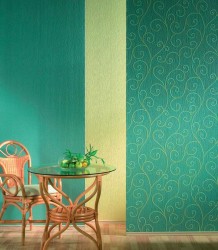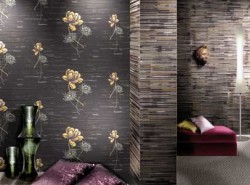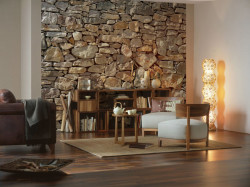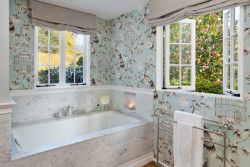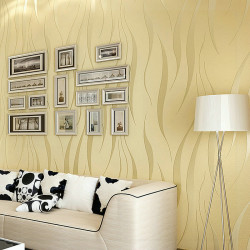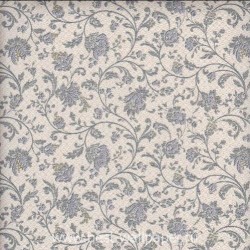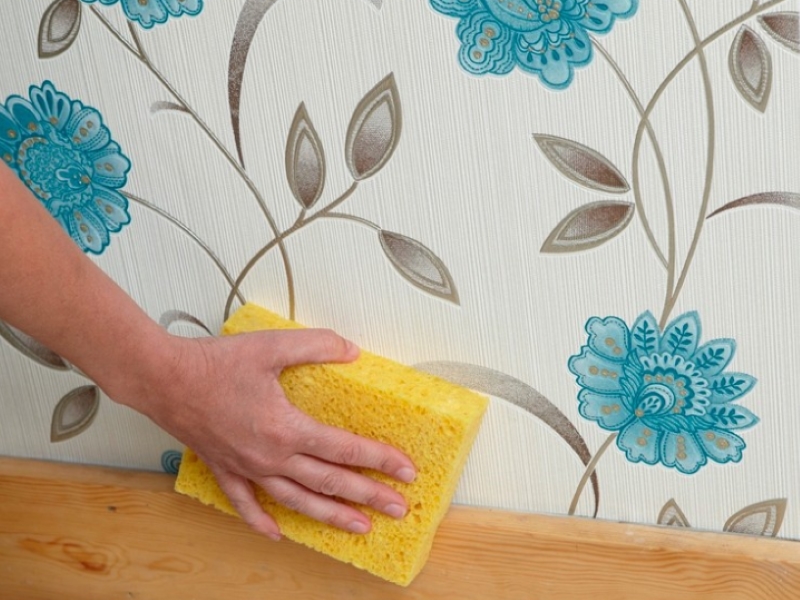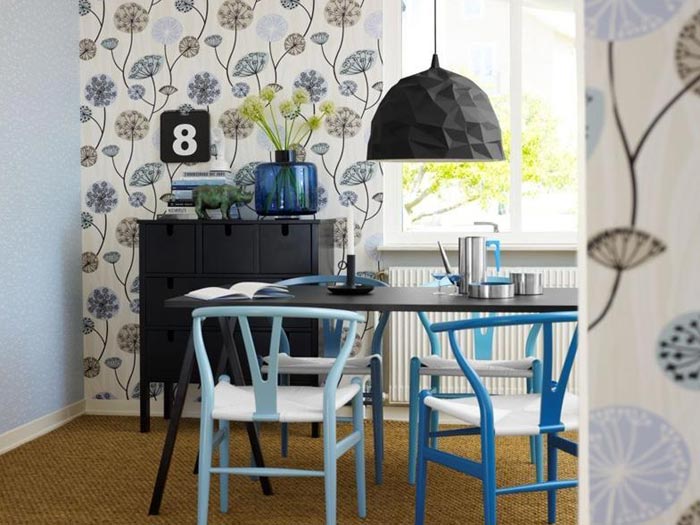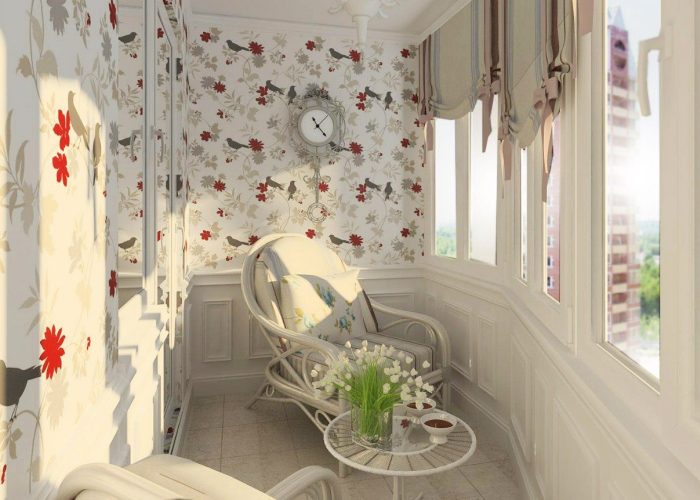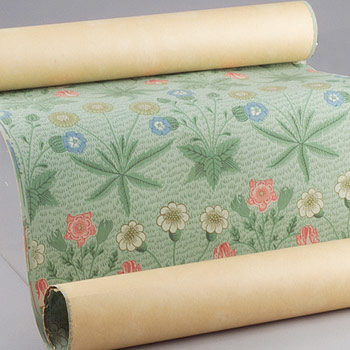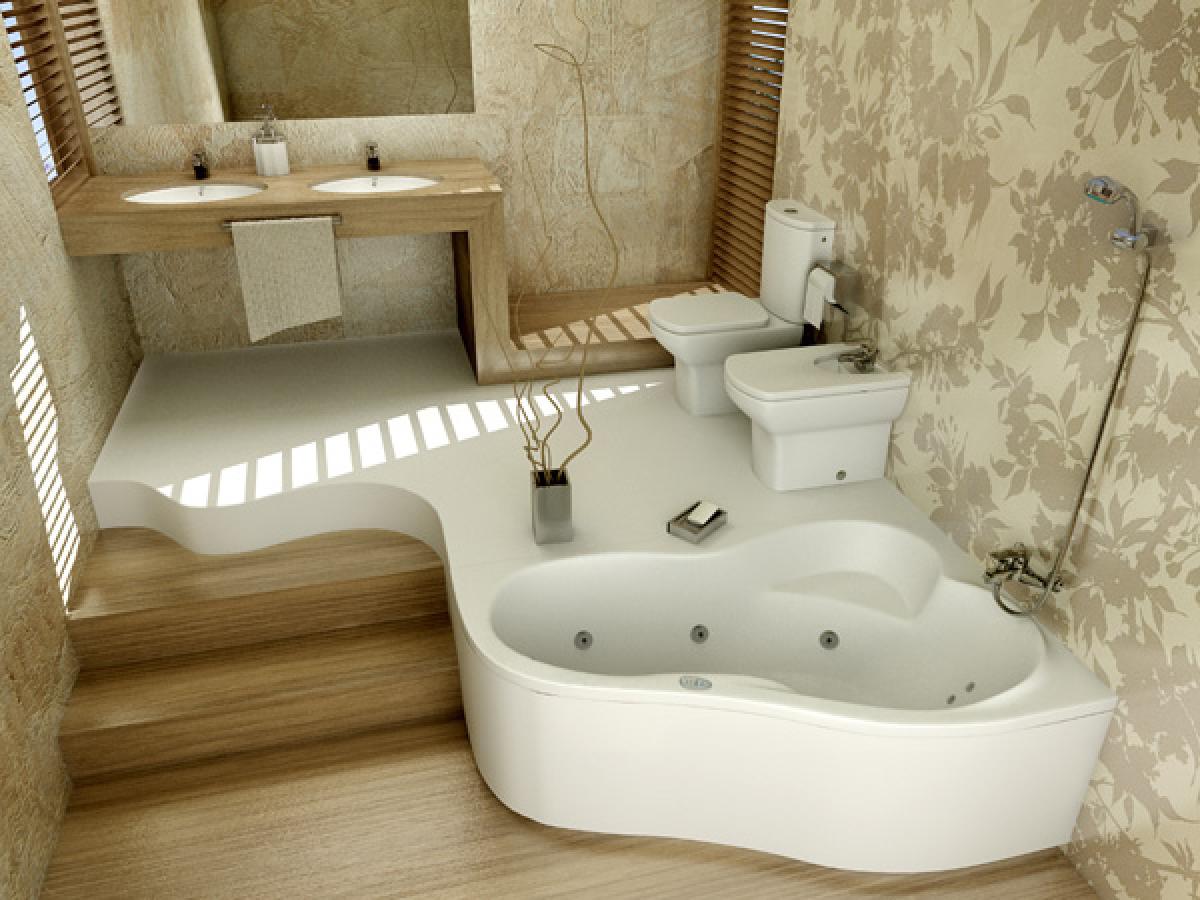Vinyl wallpapers: selection and sticking
Each of us, starting repair work, first of all, thinks about the future interior of the room. Wall decoration - One of the most important issues to be resolved. The modern market offers so many different options that your eyes just run up, but many choose a traditional and decades-proven option - wallpaper. But if a couple of dozen years ago at the peak of popularity were paper wallpapertoday vinyl won the palm. They are amazing variety, performance and relative ease of installation. This is a universal option that is suitable for almost all rooms in the apartment. But to get a great result, you first need to figure out how to choose vinyl wallpapers, how to stick them, and what they are.
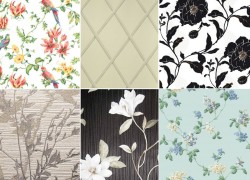 What are vinyl wallpapers? They consist of two layers: the upper or front is made of polyvinyl chloride, hence the name, and the lower, main layer, can be paper or non-woven. The top layer can be of any color and texture, imitate any material, it perfectly resists a wide variety of dirt and mechanical damage. Non-woven backing much stronger than paper, more durable and durable, but also more expensive.
What are vinyl wallpapers? They consist of two layers: the upper or front is made of polyvinyl chloride, hence the name, and the lower, main layer, can be paper or non-woven. The top layer can be of any color and texture, imitate any material, it perfectly resists a wide variety of dirt and mechanical damage. Non-woven backing much stronger than paper, more durable and durable, but also more expensive.
Both non-woven and paper are breathable, but the vinyl layer cannot boast of such a feature, which is one of its main disadvantages. Today in the collections of some European manufacturers have already appeared vinyl wallpaper that can "breathe"but they cost a lot, and so far not very common.
Advantages and disadvantages of vinyl wallpaper
Before proceeding with the selection and sticking, you must carefully weigh all the pros and cons of vinyl wallpaper.
The advantages include:
 boundless diversity options that differ in color, topography, can imitate wood, stone, leather, fabric, etc. With vinyl wallpaper you can easily realize any interior dream;
boundless diversity options that differ in color, topography, can imitate wood, stone, leather, fabric, etc. With vinyl wallpaper you can easily realize any interior dream;- vinyl wallpaper can easily mask small defects and uneven walls;
- relatively low cost;
- vinyl wallpapers can even be used in rooms with high humiditywithout fear of harming their appearance. In addition, they are resistant to differences in humidity;
- over time, even in the sunniest rooms such wallpaper won't fade and do not lose their former appearance;
- durability;
- non-woven vinyl wallpapers take on the shape of a wall, don't shrink, therefore, can be used even in new buildings.
There are some negative aspects:
 air tightness, which can adversely affect the microclimate of the room, so you should not use such decoration for a children's room. If, nevertheless, the choice fell on vinyl wallpaper, then it is better to find those that will let air through, but such a decision will cost a lot;
air tightness, which can adversely affect the microclimate of the room, so you should not use such decoration for a children's room. If, nevertheless, the choice fell on vinyl wallpaper, then it is better to find those that will let air through, but such a decision will cost a lot;- with some types of vinyl wallpaper you may experience difficulty stickingwhich are associated with expansion when wet and narrowing when dry. As a result, there may be a problem with fitting the seams;
- some samples specifically smellbut the smell usually disappears quickly with the right ventilation.
How to choose a vinyl wallpaper?
Vinyl wallpapers of different types may vary slightly in performance and performance. Depending on where the wallpaper will be glued, and what requirements are put forward for them, you can choose one of the following types:
 foamed vinyl. This is one of the most common wallpaper options that can be recognized by relief. They are produced by cold stamping, and their surface is never smooth. Their difference is very low weight, therefore volumetric-looking rolls are light in weight. Due to this relief, the wallpaper can hide small irregularities and even cracks on the walls. Moreover, before they are glued, the walls do not require careful preparation. It is very easy to glue them, and due to their minimum weight, they will stay on the wall for a long time;
foamed vinyl. This is one of the most common wallpaper options that can be recognized by relief. They are produced by cold stamping, and their surface is never smooth. Their difference is very low weight, therefore volumetric-looking rolls are light in weight. Due to this relief, the wallpaper can hide small irregularities and even cracks on the walls. Moreover, before they are glued, the walls do not require careful preparation. It is very easy to glue them, and due to their minimum weight, they will stay on the wall for a long time;- silk screen printing. Contrary to the name, there are no silk threads in such vinyl wallpapers, and the main feature of their production is the use of hot stamping. This type of vinyl wallpaper is also popular in the modern construction market, as it combines a lot of advantages: chic appearance, the ability to choose any pattern and texture, durability, strength. They can resemble textile wallpaper, metal surface, decorative stone, etc. - a lot of options. The outer surface of such wallpaper, as a rule, is strong and smooth, can be matte or glossy;
 smooth vinyl (kitchen or thick vinyl). These wallpapers are perfect for rooms with high humidity, in particular for kitchens and bathtubs. They are made of rubberized vinyl. The finished product looks very dense, but it has amazing performance properties: it is dirt-repellent, waterproof, it can be washed. Such wallpapers can easily replace ceramic tiles. Despite the name of this type of wallpaper, they are not always smooth, but may also have a relief surface. As for the variety of drawings and textures, there are a lot of them, so any design idea can be easily implemented. Caring for them is also as simple as possible, and some manufacturers offer wallpapers that can be cleaned even with a washing vacuum cleaner. With all these advantages, this type of decoration can only be used in bathrooms and kitchens, and in no case in a nursery or bedroom. Firstly, these wallpapers are thick and rough, and secondly, they are not environmentally friendly enough for use in such rooms;
smooth vinyl (kitchen or thick vinyl). These wallpapers are perfect for rooms with high humidity, in particular for kitchens and bathtubs. They are made of rubberized vinyl. The finished product looks very dense, but it has amazing performance properties: it is dirt-repellent, waterproof, it can be washed. Such wallpapers can easily replace ceramic tiles. Despite the name of this type of wallpaper, they are not always smooth, but may also have a relief surface. As for the variety of drawings and textures, there are a lot of them, so any design idea can be easily implemented. Caring for them is also as simple as possible, and some manufacturers offer wallpapers that can be cleaned even with a washing vacuum cleaner. With all these advantages, this type of decoration can only be used in bathrooms and kitchens, and in no case in a nursery or bedroom. Firstly, these wallpapers are thick and rough, and secondly, they are not environmentally friendly enough for use in such rooms; hard vinyl - a relatively new coating, which has not yet found wide distribution in the domestic market. This is a dense and durable material that can perfectly be used in conditions of high humidity, but at the same time it is breathable. It can have any color, pattern and relief, repeating the texture of stone, wood, leather, Venetian plaster.
hard vinyl - a relatively new coating, which has not yet found wide distribution in the domestic market. This is a dense and durable material that can perfectly be used in conditions of high humidity, but at the same time it is breathable. It can have any color, pattern and relief, repeating the texture of stone, wood, leather, Venetian plaster.
Naturally, you need to choose the type of vinyl wallpaper, starting from the type of room where they will be used, and only then be determined with color and other purely aesthetic parameters. By the way, it is worth noting that if the walls are not smooth enough, then you can hide all the defects with the help of volumetric wallpapers, and smooth matte ones only emphasize all the flaws.
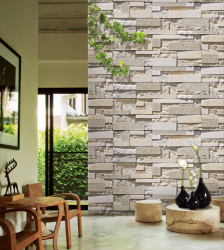 In addition, it is also important to be immediately aware on what basis the wallpaper should be. Of course, if it is a kitchen or bath, it is better to choose non-woven, and for the living room, bedroom or study you can use more affordable vinyl paper-based wallpapers.
In addition, it is also important to be immediately aware on what basis the wallpaper should be. Of course, if it is a kitchen or bath, it is better to choose non-woven, and for the living room, bedroom or study you can use more affordable vinyl paper-based wallpapers.
FROM choice of color and pattern everyone can cope on their own: it all depends on their own taste and future interior. But still, do not glue dark wallpapers in dark rooms, and cold shades and vice versa in rooms with windows to the north. If the room is small, then it is also better to refuse too large drawings on the wallpaper. But thanks to the vinyl wallpaper, you can create an imitation of brickwork, tiles, fabric coatings, etc. on the walls.
In addition, having decided on the type and design of wallpaper, and going to make a purchase, pay attention to some subtleties:
 All wallpaper rolls should be in one batch and made at the same time. At first glance, the same wallpaper may vary in color if they were made at different times. In the room it will be very noticeable;
All wallpaper rolls should be in one batch and made at the same time. At first glance, the same wallpaper may vary in color if they were made at different times. In the room it will be very noticeable;- plastic packaging should be holistic;
- sticking instructions should be available;
- compliance with all standards and norms;
- if the price is below the market, then such wallpapers are unlikely to surprise you with quality. So think carefully before you make such a deal;
- The name of the manufacturer today means a lot, so it is better to give preference to well-known and reputable companies.
How to stick vinyl wallpaper?
In principle, the process of gluing vinyl wallpapers is not that complicated, and almost everyone can handle it. But still there are a few nuances that are worth paying attention to.
First of all, you need to figure out what tools will be needed:
- selected wallpaper;
- level, ruler and knife;
- primer brush;
- glue roller;
- spatula for smoothing wallpaper;
- seam rolling roller;
- a rag or sponge to wipe off any excess glue;
- a small brush for gluing wallpaper in hard to reach places.
Surface preparation
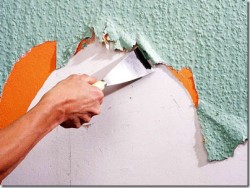 Before starting work, you need to get rid of the traces of the old coating and align the walls. Small defects can be puttied, and in the presence of large irregularities can need plaster or even drywall, with sheets of which you can simply and quickly align the walls.
Before starting work, you need to get rid of the traces of the old coating and align the walls. Small defects can be puttied, and in the presence of large irregularities can need plaster or even drywall, with sheets of which you can simply and quickly align the walls.
After leveling, a primer is applied to the walls. If the walls are concrete, then you can’t do without a primer at all, otherwise spots may appear on the wallpaper. You can use special compounds or just dilute wallpaper glue. It is also desirable to treat the surface with a fungicidal composition for prevent mold.
On the wall, it is better to draw a vertical line strictly according to the level so that the wallpaper canvases are glued as evenly as possible. Before sticky take off skirting boards, covers of sockets and switches.
Wallpaper Cutting
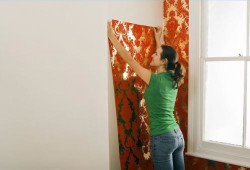 Before you open the wallpaper rolls, make sure once again that they have the same pattern, and that they belong to the same batch. Cut plain wallpaper - This is not a troublesome task: you only need to know the height of the wall and leave a few centimeters below and above for allowances.
Before you open the wallpaper rolls, make sure once again that they have the same pattern, and that they belong to the same batch. Cut plain wallpaper - This is not a troublesome task: you only need to know the height of the wall and leave a few centimeters below and above for allowances.
If the wallpaper is marked, then it must be combined correctly. Cutting in this case is carried out taking into account the combination of the pattern, and the allowances will take much more wallpaper. On the reverse side, each canvas is numbered, and it indicates where the top and bottom are. If you have chosen a wallpaper with a pattern, then it is better to buy them with a good supply.
Wallpapering
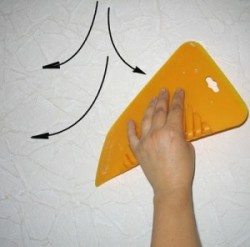 First you need to cook wallpaper glue. It is better to choose special compositions for vinyl wallpaper and prepare them exactly in accordance with the instructions and let it swell for 10 minutes. The wallpaper must have a marking of how to glue them: apply glue to the wall or wallpaper. By the way, there is a wallpaper on which glue has already been applied, and in this case the task is simplified as much as possible.
First you need to cook wallpaper glue. It is better to choose special compositions for vinyl wallpaper and prepare them exactly in accordance with the instructions and let it swell for 10 minutes. The wallpaper must have a marking of how to glue them: apply glue to the wall or wallpaper. By the way, there is a wallpaper on which glue has already been applied, and in this case the task is simplified as much as possible.
If the glue needs to be applied to the wall, then the roller should be coated with a portion of the wall under the first canvas. If the canvas is glued, then it is unnecessary to apply too much glue to it, otherwise it can stretch noticeably: the glue is applied with a roller in a uniform thin layer.
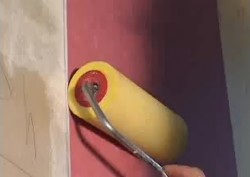 Experts recommend starting gluing from the window and working together, holding the canvas on top and bottom. After you attach it to the wall, carefully with a roller you need to squeeze out excess glue and air bubbles from under it. Movements are made from the center of the strip to its edges. The exposed glue is immediately wiped with a sponge or cloth.
Experts recommend starting gluing from the window and working together, holding the canvas on top and bottom. After you attach it to the wall, carefully with a roller you need to squeeze out excess glue and air bubbles from under it. Movements are made from the center of the strip to its edges. The exposed glue is immediately wiped with a sponge or cloth.
When the strip of wallpaper is glued, you can cut off the allowances. Near the ceiling it is completely removed, cutting off with a sharp knife and holding the edges with a spatula.The lower edge of the wallpaper should go 4-6 mm under the baseboard.
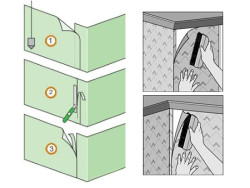 With the next strip we do the same. Vinyl wallpapers glued butt, so you need to be very careful and focused. If you chose plain wallpaper, then the task is simplified. It is possible to glue the canvases with an overlap, then cut through the place of their overlapping in the middle with a knife and remove two thin formed strips. The result is a perfect fit.
With the next strip we do the same. Vinyl wallpapers glued butt, so you need to be very careful and focused. If you chose plain wallpaper, then the task is simplified. It is possible to glue the canvases with an overlap, then cut through the place of their overlapping in the middle with a knife and remove two thin formed strips. The result is a perfect fit.
Places where sockets and switches are installed are sealed, and after drying the glue, slots are made in their place. Behind radiators, for example, wallpapers do not glue, since this is a laborious process. The walls there can be painted to match the wallpaper and all, if possible.
Optimal conditions for these works - temperature 20-240C and lack of drafts.
In conclusion
Vinyl wallpapers - a universal option for wall decoration. They are suitable for any type of premises, as they come in different types, they can satisfy any design idea, since a wide variety of patterns and textures are produced. It is not difficult to cope with the sticking, and even a beginner can do it, but if you are not completely sure of your abilities, you should start by decorating the hallway or the corridor, so that later in the living room or bedroom you can perfectly glue the vinyl wallpaper.

